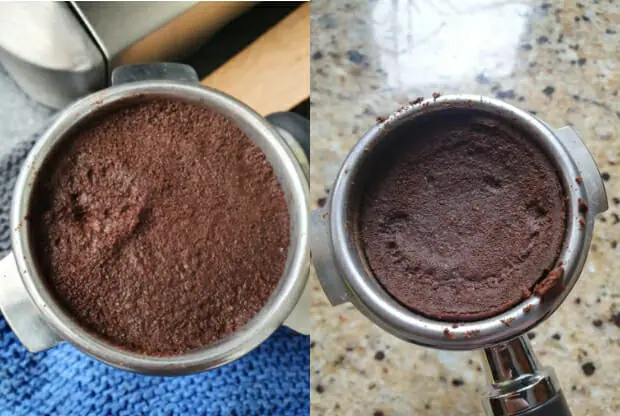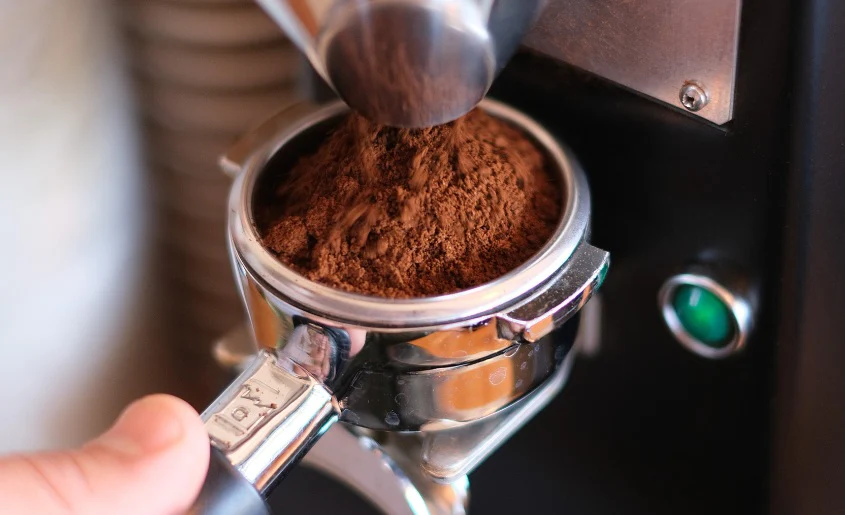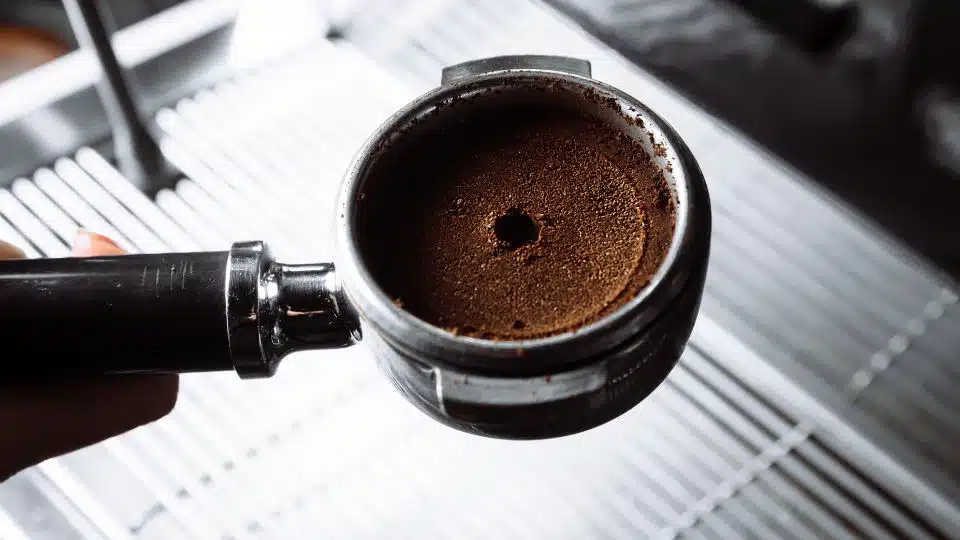How can I tell if my espresso is channeling?
Experiencing bitter or sour espresso shots? Espresso channeling could be the culprit. It occurs when water flows unevenly through the coffee puck, causing inconsistent extraction. This article about espresso channeling explained how to identify, fix, and prevent it for a perfect brew.

Key Takeaways
Espresso channeling disrupts flavor balance by causing uneven extraction, leading to both over-extraction and under-extraction within the coffee puck.
Common causes of channeling include incorrect grind size, poor coffee distribution, and inconsistent tamping pressure, all of which significantly affect espresso quality.
Preventing channeling involves proper techniques such as adjusting grind size, ensuring even coffee distribution, and using consistent tamping methods, supported by quality equipment.
Understanding Espresso Channeling

Espresso channelling is the localized extraction of certain areas in an espresso puck, where water flows rapidly through weak spots rather than evenly through the coffee bed. This uneven flow causes over-extraction in some areas and under-extraction in others, resulting in a shot that lacks balance and complexity. Essentially, espresso channelling indicates that the water is not flowing through the coffee as intended, but rather finding paths of least resistance, leading to what is known as channelled espresso.
When espresso channeling occurs, it disrupts the desired balance of flavors. Over-extracted areas can taste bitter and harsh, while under-extracted zones might be sour and weak. The combination of these uneven flavors leads to a disappointing cup of espresso that fails to showcase the coffee’s true potential. Severe channeling can even make the espresso undrinkable, leaving a mess of conflicting tastes that no amount of milk or sugar can mask.
The impact of channeling goes beyond just flavor. It also affects the overall quality and satisfaction of the espresso shot. For home baristas striving for perfection, understanding and addressing channeling is crucial. Recognizing the signs and understanding the causes allows you to take proactive steps for near-perfect espresso shots.
Understanding espresso channeling is essential for mastering your machine and achieving consistent, high-quality extractions. Identifying the signs early enables timely adjustments.

Identifying Signs of Espresso Channeling

Recognizing the signs of espresso channeling is crucial for diagnosing and correcting the issue. One visible indication is when the espresso flows from specific areas instead of evenly across the puck. This uneven flow often appears as thin streams or jets of water shooting out from the bottom of the portafilter, signaling that channeling is occurring.
A naked portafilter, also known as a bottomless portafilter, provides valuable visual feedback by exposing the bottom of the portafilter baskets, allowing direct observation of the extraction process. This tool makes it easier to spot gaps in the espresso flow, uneven coverage, and any signs of jetting or spraying water, which are dramatic indicators of channeling.
Taste can also reveal channeling problems. A sour and acidic shot might be under-extracted due to channeling, while an overly bitter one indicates over-extracted areas in the puck. By paying attention to both the visual and taste indicators, you can better diagnose and address espresso channeling issues, ensuring a more balanced and satisfying shot.
Common Causes of Espresso Channeling

Preventing espresso channeling starts with understanding its common causes, such as grind size issues, poor coffee distribution, and uneven tamping techniques. Each of these elements plays a crucial role in the overall quality of the espresso extraction.
Grind size is particularly influential, as it directly affects how water flows through the ground coffee bed. Poor coffee distribution creates weak spots in the puck, leading to channeling. Additionally, inconsistent tamping pressure can cause uneven surfaces in the coffee bed, further contributing to the problem.
Each of these factors impacts espresso extraction in unique ways.
Grind Size Issues
The grind size of your coffee is a fundamental factor in preventing channeling. If the grind is too fine, it can obstruct water flow, causing it to seep through cracks instead of evenly saturating the coffee bed. This obstruction can lead to an uneven extraction yield, resulting in undesirable flavors in the espresso shot.
The perfect grind size depends on your espresso machine and coffee beans. Adjusting to a finer grind can help reduce channeling, but it must be balanced with the right dose to avoid bitterness.

Experimenting with different grind sizes and monitoring extraction results will help find the sweet spot for making espresso that is balanced and flavorful.
Poor Coffee Distribution

Poor coffee distribution is another common cause of channeling, leading to uneven extraction. Uneven grind distribution creates differing densities in the coffee puck, resulting in channeling. When coffee grounds are unevenly distributed, some areas of the puck become denser than others, causing water to flow through the least resistant paths.
One effective method to achieve even coffee distribution is using the Weiss Distribution Technique (WDT), which involves stirring the coffee grounds with a fine needle to break up clumps and create a uniform density. Tools like the WDT tool and other distribution tools can help ensure that the coffee grounds are evenly spread within the portafilter basket, minimizing the risk of channeling.
Exercising caution with distribution tools is crucial to avoid over-distribution, which may cause clumping and subsequent channeling. By carefully preparing the coffee puck and using appropriate distribution techniques, you can enhance the resilience of the coffee bed against channeling, leading to more consistent and satisfying espresso shots.
Uneven Tamping
Uneven tamping is a significant contributor to espresso channeling. If the tamping pressure is inconsistent, it creates paths of least resistance for water, leading to uneven extraction. This inconsistency can cause water to flow faster through thinner parts of the puck, resulting in both over-extracted and under-extracted areas.
Achieving a consistent tamp requires pressing until the coffee is fully compressed and ensuring the tamp remains level. A quality tamper and lightly tapping the portafilter before tamping can significantly improve consistency and reduce the risk of channeling.
Mastering even tamping ensures more uniform extraction and a better-tasting espresso shot.
Diagnosing and Troubleshooting Espresso Channeling

Diagnosing and troubleshooting espresso channeling involves closely observing the shot as it exits the portafilter. Uneven flow, such as thin streams or jets of water, indicates channeling issues. When channeling occurs, it often leads to variations in extraction quality, with some parts of the coffee puck becoming over-extracted while others are under-extracted.
Taste is a crucial diagnostic tool. Under-extracted coffee, which may taste sour, can signal channeling during brewing. Conversely, over-extracted coffee tends to be bitter, another indicator of channeling. By paying attention to these taste cues, you can better understand the extent of channeling and take steps to address it.
Troubleshooting requires adjustments to grind size, coffee distribution, and tamping techniques. Observing the shot, tasting for balance, and experimenting with variables will help identify the root cause of channeling and refine your process.
Techniques to Prevent Espresso Channeling

Preventing espresso channeling requires a blend of proper techniques and quality equipment. Ensuring even grind size, proper coffee distribution, and consistent tamping effectively mitigates channeling. Additionally, using a quality grinder, like the Baratza Vario+, helps achieve consistent particle size, improving extraction and reducing channeling.
Incorporating pre-infusion capabilities in your espresso machine can also help by saturating the coffee grounds evenly before full pressure is applied. Experimenting with pre-infusion times of 5 to 12 seconds can help find the optimal setting for different beans, further enhancing your espresso shots.
Proper Grind Adjustment
Proper grind adjustment prevents espresso channeling. A grind that’s not excessively fine helps prevent water from finding paths that lead to channeling. Adjusting the grind size finer can help but must be balanced with the right dose to avoid bitterness.
Experimenting with different grind sizes and monitoring extraction results will help find the sweet spot for a balanced, flavorful espresso. By fine-tuning your grinder settings, you can achieve optimal espresso extraction and minimize the risk of channeling.
Even Coffee Distribution
Even coffee distribution prevents espresso channeling. Channeling can occur due to underfilling or overfilling the portafilter basket. Techniques like the Weiss Distribution Technique (WDT) help achieve even distribution, minimizing the risk.
Tools like the WDT tool ensure coffee grounds are evenly spread within the portafilter basket. Carefully preparing the coffee puck and using appropriate distribution techniques enhance the coffee bed’s resilience against channeling, resulting in more consistent shots.
Consistent Tamping Pressure
Consistent tamping pressure prevents espresso channeling. Even saturation of the coffee bed reduces the risk and promotes uniform extraction. Proper tamping requires pressing until fully compressed and ensuring the tamp remains level.
Using a quality tamper and lightly tapping the portafilter before tamping can significantly improve tamp consistency and decrease channeling risk. Mastering even tamping ensures more uniform extraction and a better-tasting espresso shot.
The Role of Equipment in Reducing Channeling

The right equipment is vital for reducing espresso channeling. A high-quality tamper and ensuring a tight fit with the portafilter basket improve the coffee bed’s consistency. The tamper’s role is to seal the coffee bed before extraction, with factors like diameter, weight, and material being crucial.
Automated tamping machines ensure consistent pressure, enhancing overall espresso extraction and reducing channeling risk. Investing in quality equipment improves the consistency and quality of your shots.
Advanced Tips for Home Baristas

Advanced techniques can significantly elevate a home barista’s espresso game. A WDT tool helps distribute coffee grounds evenly, reducing channeling. Experimenting with grind size is crucial; coarser grinds may lead to a sweeter shot, while finer grinds could cause bitterness and channeling.
Pre-infusion moistens the puck, allowing it to expand and minimizing uneven extraction and channeling. A bottomless portafilter provides visual feedback, enabling technique adjustments. These advanced tips help home baristas achieve more consistent and flavorful shots.
Summary
Mastering espresso channeling involves understanding its causes, recognizing the signs, and implementing proper techniques to prevent it. From adjusting grind size and ensuring even coffee distribution to maintaining consistent tamping pressure, each step plays a crucial role in achieving a balanced and flavorful espresso shot.
Investing in quality equipment and experimenting with advanced techniques can further enhance your espresso-making skills. By addressing channeling issues head-on, you can transform your home barista experience and consistently pull the perfect shot of espresso every time.
Frequently Asked Questions
What is espresso channeling?
Espresso channeling is a phenomenon where water preferentially flows through weak spots in the coffee puck, leading to uneven extraction and subpar flavors in your espresso. To achieve a better shot, ensure an even distribution and tamping of the coffee grounds.
How can I tell if my espresso is channeling?
If your espresso is channeling, you may notice uneven flow, thin streams of water from the portafilter, and a sour or bitter taste. Look for visible gaps in the espresso flow as a clear indicator of this issue.
What causes espresso channeling?
Espresso channeling is primarily caused by improper grind size, uneven coffee distribution, and inconsistent tamping pressure. Addressing these factors will help you achieve a more balanced extraction.
How can I prevent espresso channeling?
To prevent espresso channeling, focus on proper grind adjustment, use techniques like the Weiss Distribution Technique for even coffee distribution, and maintain consistent tamping pressure. These practices will help you achieve a more uniform extraction.
What role does espresso machine equipment play in reducing channeling?
Using quality equipment like a reliable tamper and grinder is essential for improving the consistency of the coffee bed, which effectively reduces the risk of channeling. Automated tampers can further enhance this consistency by ensuring uniform tamping pressure.






